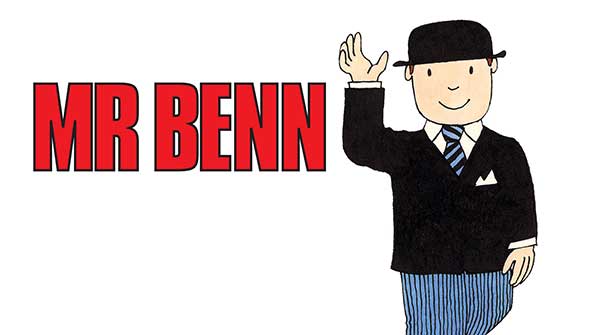Enough with loud and annoying characters. Mr Benn uses wit, charm and imagination to take children on incredible adventures
 Some young children in Canada were probably a bit confused this week.
Some young children in Canada were probably a bit confused this week.
They woke up early, grabbed the TV remote and clicked on Teletoon.
Except it wasn’t there.
“Where’s Teletoon?” they may have asked their Moms and Dads. “It’s gone!”
Well, yes and no.
Corus Entertainment announced on Feb. 21 that the 25-year-old Teletoon was going to be rebranded as Cartoon Network. In turn, the old Cartoon Network would be rebranded as Boomerang. This follows a similar model in the U.S. and other countries.
 |
| Related Stories |
| Riding the Toonerville Trolley in Kentucky…or New York?
|
| How a controversial poll obliterated a cartoonist’s career
|
| Murdoch Mysteries – then and now
|
Teletoon’s final day was Mar. 27. The name is still used with its streaming service, albeit as Teletoon+. The French language version, Télétoon, will also remain intact.
Not to worry, kids! Your daily dose of cartoons hasn’t disappeared.
Although that wouldn’t necessarily be a bad thing in North America.
Animated series for children aren’t what they used to be. The overall presentation has improved as the industry moved from hand-drawn cells to computer-generated images. Alas, the show quality and level of storytelling have declined. Characters have also become louder, screechier – and more annoying.
Don’t believe me?
TV series originating or animated in Canada have included the likes of The Adventures of Paddington Bear, Babar, The Berenstain Bears, George and Martha, Gerald McBoing-Boing, Inspector Gadget, Little Bear, Rocket Robin Hood, The Secret World of Benjamin Bear and Simon in the Land of Chalk Drawings.
Pretty good list, all things considered.
What defines today’s Canadian animation? Caillou, Hero Elementary, Let’s Go Luna!, Max and Ruby, My Big Big Friend, Ollie’s Pack, PAW Patrol and Toopy and Binoo.
Yes, times change, tastes change, and people change. I get that.
With all due respect to the various animators and the children who compose each show’s fan base, these two lists of animated series aren’t even comparable at the most basic level.
I’m not picking on the Canadian animation industry, either. Most countries around the world, including the U.S., suffer from the same fate.
What’s my solution? You can still have some modern elements and touches that appeal to today’s young viewers. However, creating animated series with more depth, intelligence, and imagination won’t detract from its entertainment value and children’s fun.
Here’s an example.
Mr Benn, created by writer/illustrator David McKee, remains one of Britain’s most popular and beloved children’s characters.
He was depicted as an ordinary man living an ordinary life on an ordinary street, 52 Festive Road. This changed when he was invited to a fancy dress party and needed to get an outfit. After looking through big and not-so-big shops with no success, Mr Benn found a little shop selling a suit of red armour. He spoke to the fez-wearing shopkeeper, who suggested he try it on in a changing room. This led him to open the door to a world of adventure – with others to follow.
McKee originally released four Mr Benn stories: Mr Benn, Red Knight (1967), 123456789 Benn (1970), Big Game Benn (1979) and Big Top Benn (1980). A fifth book, Mr. Benn, Gladiator, was published in 2001.
The author also collaborated with Ian Lawless to create a popular animated series about his titular character. Thirteen episodes of Mr Benn appeared on BBC1 between 1971-1972. They were repeated twice a year for over two decades. The final Mr Benn book was animated as a one-off special on The Noggin Channel in 2005.
Mr Benn took on several identities, including knight, clown, balloonist, zoo keeper and Roman gladiator: he became part of history. He also taught young children about history. He always took a souvenir home after the shopkeeper extracted him from his adventure as a reminder of what he had done.
He was an ordinary man who became a real hero.
McKee passed away in 2022, but he watched his creation become part of British lore.
The Mr Benn books are still published by Andersen Press. There’s a 2005 DVD containing all 14 episodes. He’s appeared in ads for R Whites Lemonade (1993), MR PORTER (2013) and The Insurance Emporium (2018). Three limited edition pocket squares of Mr Benn were released by Turnbull & Asser in 2017. He was adapted for the stage by Tall Stories Theatre Company. A 2001 movie was planned but remains on hold.
There’s even a popular Twitter handle, @therealmrbenn. It was linked with the character dating back to 1994, but a “change in ownership” ended that association in 2019. The anonymous individual who runs it has done a magnificent job of keeping the true spirit of Mr Benn alive. He’ll even doff his bowler hat to fans and admirers alike.
How did I discover Mr Benn in Canada? My neighbourhood library carried some of the books. Why they were on the shelves is anyone’s guess, but I’m not complaining!
Imagine if there was a Canadian Mr Benn. A character who wasn’t loud, obtuse or silly but used his wit, charm and vivid imagination to have incredible adventures. It would establish a lifelong connection between parents and children for generations to come.
That’s what children’s animated series used to do.
That’s what Cartoon Network and Boomerang should strive for in Canada.
That’s what I hope will happen – and maybe you do, too.
Michael Taube, a Troy Media syndicated columnist and Washington Times contributor, was a speechwriter for former prime minister Stephen Harper. He holds a master’s degree in comparative politics from the London School of Economics.
For interview requests, click here.
The opinions expressed by our columnists and contributors are theirs alone and do not inherently or expressly reflect the views of our publication.
© Troy Media
Troy Media is an editorial content provider to media outlets and its own hosted community news outlets across Canada.


